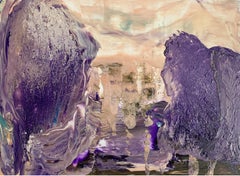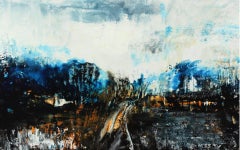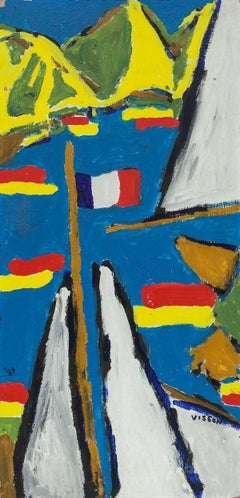Philippe Visson Art
to
1
1
1
Overall Height
to
Overall Width
to
1
1
1
6,934
3,277
2,514
1,216
1
1
1
1
Artist: Philippe Visson
Liberte, Egalite, Fraternite, Modernist Painting
By Philippe Visson
Located in Surfside, FL
Philippe Visson, (1942-2008), whose parents were both of Russian origin, was born in New York in 1942.
His mother, a Parisian art historian, was the Editor of La Gazette des Beaux-Arts from 1930 to 1960, and had always frequented the international artistic milieu. His father was a major political journalist for The Washington Post and Roving Editor for The Reader’s Digest. Philippe Visson therefore was raised in a cosmopolitan milieu between the United States and Europe. At the Vissons, one devours; one spends beyond one’s means; one falls, but only to land on one’s feet.
Visson is a painter to whom it is difficult to assign a particular movement in art history; and that, principally for two reasons: firstly, his origins,his education and his way of life have produced a personality without any true roots, but rather a citizen of the world, who carries with him all cultures, from pre-Revolutionary Russia to the black ghetto of Washington, D.C.
Secondly, he is self-taught, and can work in complete solitude, as well as before a large audience. His art is therefore uniquely his own, and certainly not that of an Art Brut ‘author’. His faces, his anti-portraits, reveal a continuum of humanity’s facets: from Christ to the demon, from the child to the aged, from the Caucasion to the African.
Biography
Philippe Visson, whose parents were both of Russian origin, was born in New York in 1942. His mother, a Parisian art historian, was the Editor of “The Gazette des Beaux-Arts” and had always frequented the international artistic milieu. His father was a major American political journalist for “The Washington Post” and “The Readers Digest”. Philippe Visson therefore was raised in a cosmopolitan milieu between the United States and Europe.
He starts to paint in the bathroom of Parisian luxury hotel at the age of 16, working in a frenzy and without art lessons. He’s immediately confronted with the scrutiny of professional experts that surround his parents. He has instant success when he shows at the Craven Gallery in Paris in December, 1958, quickly offered to him; then in New York in the Milch Galleries in May, 1959; followed by shows in Monte Carlo, Geneva and New York again. It was too much, too soon. Visson falls into drinking.
Returning to Washington, D.C. on 1960, the period 1963-1979 is differentiated by a life that is sometimes social, sometimes reclusive, which continues when his family settles in a large villa in Switzerland (Epalinges above Lausanne) in the mid-sixties. Visson has stopped drinking. He paints in one of the rooms of his parents’ house and inundates all the empty rooms with his productions that remain hidden from the public, allowing them to be seen only by personalities such as Marcel Brion and René Huyghe, both of the Académie Française; or Jean Leymarie, Director of the Museum of Modern Art in Paris.
It’s only at the start of the seventies that he once again opens his work to the public. He meets several important cultural figures of the time, such as René Berger, Director of the State Fine Arts Museum of Lausanne; and Michel Thévoz, future Director of the Art brut Museum.
After the death of his father in 1973, he settles without money with his mother in a luxury hotel in Paris. It’s only after a year and a half of perpetual and colorful adventures that they return to Washington, D.C., where he resumes painting and produces a unique period of abstracts.
Returning to Switzerland at the death of his mother in the beginning of the eighties, Visson meets with blatant success in Switzerland, where institutions exhibit and purchase his paintings (Aarau State Fine Arts Museum, the Federal Office of Culture in Bern). His fury for painting takes the form of an explosion while remaining focused (he always keeps what he considers the best paintings for himself).
After the life of a hermit in the Paccots, Visson comes down from his mountain to settle in Montreux on the Swiss Riveria. This moving is marked by a sort of return to social life, despite the fact that he paints in a cellar. A period of public projects with charitable goals is launched. Visson thrives on this contact with the public.
This changes somewhat when he receives a working studio in The Montreux Palace in the late nineties. This emerging from the cellars denotes a new era for the artist. He starts an intense period of painting, and moves six thousand of his paintings to the Palace. He continues his public projects, including the acquisition against paintings of a Stradivarius violin...
Category
Late 20th Century Modern Philippe Visson Art
Materials
Acrylic, Board
Related Items
Landscape - XXI century Acrylic painting, Abstaction & Figurative
By Monika Rossa
Located in Warsaw, PL
acrylic on plastic board
MONIKA ROSSA
studied painting at the University of Arizona, in the Ecole des Beaux Arts in Paris and at the Escuela de Diseno in Barcelona. She practices d...
Category
21st Century and Contemporary Contemporary Philippe Visson Art
Materials
Acrylic, Board
Landscape - XXI century, Contemporary Oil & Acrylic Painting, Abstraction
By Monika Rossa
Located in Warsaw, PL
MONIKA ROSSA
studied painting at the University of Arizona, in the Ecole des Beaux Arts in Paris and at the Escuela de Diseno in Barcelona. She practices drawing and easel painting....
Category
21st Century and Contemporary Abstract Philippe Visson Art
Materials
Oil, Acrylic, Board
Landscape - XXI century, Contemporary Oil & Acrylic Painting, Abstraction
By Monika Rossa
Located in Warsaw, PL
MONIKA ROSSA
studied painting at the University of Arizona, in the Ecole des Beaux Arts in Paris and at the Escuela de Diseno in Barcelona. She practices drawing and easel painting....
Category
21st Century and Contemporary Abstract Philippe Visson Art
Materials
Oil, Acrylic, Board
Landscape - XXI century, Contemporary Oil & Acrylic Painting, Abstraction
By Monika Rossa
Located in Warsaw, PL
MONIKA ROSSA
studied painting at the University of Arizona, in the Ecole des Beaux Arts in Paris and at the Escuela de Diseno in Barcelona. She practices drawing and easel painting....
Category
21st Century and Contemporary Abstract Philippe Visson Art
Materials
Oil, Acrylic, Board
R.E.M. - Murmur (Grammy, Album Art, Iconic, Rock and Roll, Pop, Legendary)
By Kerry Smith
Located in Kansas City, MO
Kerry Smith
R.E.M. - Murmur
Mixed Media on Crescent board
Year: 2022
Size: 21x20in
Signed, dated by hand
COA provided
Ref.: 924802-1633
---------------------------------------
"Of...
Category
2010s American Modern Philippe Visson Art
Materials
Acrylic, Gouache, Board, Mixed Media
Radiohead - Amnesiac (Grammy, Album Art, Iconic, Rock & Roll, Pop, Legend)
By Kerry Smith
Located in Kansas City, MO
Kerry Smith
Radiohead - Amnesiac
Mixed Media on Crescent board
Year: 2022
Size: 21x20in
Signed, dated by hand
COA provided
Ref.: 924802-1641
---------------------------------------
...
Category
2010s Modern Philippe Visson Art
Materials
Mixed Media, Acrylic, Gouache, Board
Girls on bikes - XXI century, Contemporary Oil & Acrylic Painting, Bright Colors
By Monika Rossa
Located in Warsaw, PL
MONIKA ROSSA
studied painting at the University of Arizona, in the Ecole des Beaux Arts in Paris and at the Escuela de Diseno in Barcelona. She practices drawing and easel painting....
Category
21st Century and Contemporary Contemporary Philippe Visson Art
Materials
Acrylic, Board, Oil
Tatra sketches - Acrylic Painting, Abstract landscape, Small scale
By Sergiusz Powałka
Located in Warsaw, PL
SERGIUSZ POWALKA (born 1986)
A graduate of the Art High School in Lublin and the Faculty of Painting at the Academy of Fine Arts in Gdansk, where in 2011 he graduated from the painti...
Category
2010s Other Art Style Philippe Visson Art
Materials
Acrylic, Cardboard
Landscape - XXI century, Contemporary Oil & Acrylic Painting, Abstraction
By Monika Rossa
Located in Warsaw, PL
MONIKA ROSSA
studied painting at the University of Arizona, in the Ecole des Beaux Arts in Paris and at the Escuela de Diseno in Barcelona. She practices drawing and easel painting....
Category
21st Century and Contemporary Abstract Philippe Visson Art
Materials
Oil, Acrylic, Board
Johnny Hodges - The Big Sound (Grammy, Album Art, Iconic, Rock and Roll, Pop)
By Kerry Smith
Located in Kansas City, MO
Kerry Smith
Johnny Hodges - The Big Sound
Mixed Media on Crescent board
Year: 2016
Size: 21x20in
Signed, dated by hand
COA provided
Ref.: 91-0194
----------------------------------...
Category
2010s American Modern Philippe Visson Art
Materials
Mixed Media, Acrylic, Gouache, Board
Bob Dylan - Blood On The Tracks (Grammy, Album Art, Iconic, Folk Music, Rock)
By Kerry Smith
Located in Kansas City, MO
Kerry Smith
Bob Dylan - Blood On The Tracks
Mixed Media on Crescent board
Year: 2021
Size: 21x20in
Signed, dated by hand
COA provided
Ref.: 924802-1629
----------------------------...
Category
2010s Modern Philippe Visson Art
Materials
Mixed Media, Acrylic, Gouache, Board
Landscape - XXI century Acrylic painting, Abstaction & Figurative, Monochromatic
By Monika Rossa
Located in Warsaw, PL
acrylic on plastic board
MONIKA ROSSA
studied painting at the University of Arizona, in the Ecole des Beaux Arts in Paris and at the Escuela de Diseno in Barcelona. She practices d...
Category
21st Century and Contemporary Contemporary Philippe Visson Art
Materials
Acrylic, Board
Previously Available Items
Liberte, Egalite, Fraternite, Modernist Painting
By Philippe Visson
Located in Surfside, FL
Philippe Visson, (1942-2008), whose parents were both of Russian origin, was born in New York in 1942.
His mother, a Parisian art historian, was the Editor of La Gazette des Beaux-Arts from 1930 to 1960, and had always frequented the international artistic milieu. His father was a major political journalist for The Washington Post and Roving Editor for The Reader’s Digest. Philippe Visson therefore was raised in a cosmopolitan milieu between the United States and Europe. At the Vissons, one devours; one spends beyond one’s means; one falls, but only to land on one’s feet.
Visson is a painter to whom it is difficult to assign a particular movement in art history; and that, principally for two reasons: firstly, his origins,his education and his way of life have produced a personality without any true roots, but rather a citizen of the world, who carries with him all cultures, from pre-Revolutionary Russia to the black ghetto of Washington, D.C.
Secondly, he is self-taught, and can work in complete solitude, as well as before a large audience. His art is therefore uniquely his own, and certainly not that of an Art Brut ‘author’. His faces, his anti-portraits, reveal a continuum of humanity’s facets: from Christ to the demon, from the child to the aged, from the Caucasion to the African.
Biography
Philippe Visson, whose parents were both of Russian origin, was born in New York in 1942. His mother, a Parisian art historian, was the Editor of “The Gazette des Beaux-Arts” and had always frequented the international artistic milieu. His father was a major American political journalist for “The Washington Post” and “The Readers Digest”. Philippe Visson therefore was raised in a cosmopolitan milieu between the United States and Europe.
He starts to paint in the bathroom of Parisian luxury hotel at the age of 16, working in a frenzy and without art lessons. He’s immediately confronted with the scrutiny of professional experts that surround his parents. He has instant success when he shows at the Craven Gallery in Paris in December, 1958, quickly offered to him; then in New York in the Milch Galleries in May, 1959; followed by shows in Monte Carlo, Geneva and New York again. It was too much, too soon. Visson falls into drinking.
Returning to Washington, D.C. on 1960, the period 1963-1979 is differentiated by a life that is sometimes social, sometimes reclusive, which continues when his family settles in a large villa in Switzerland (Epalinges above Lausanne) in the mid-sixties. Visson has stopped drinking. He paints in one of the rooms of his parents’ house and inundates all the empty rooms with his productions that remain hidden from the public, allowing them to be seen only by personalities such as Marcel Brion and René Huyghe, both of the Académie Française; or Jean Leymarie, Director of the Museum of Modern Art in Paris.
It’s only at the start of the seventies that he once again opens his work to the public. He meets several important cultural figures of the time, such as René Berger, Director of the State Fine Arts Museum of Lausanne; and Michel Thévoz, future Director of the Art brut Museum.
After the death of his father in 1973, he settles without money with his mother in a luxury hotel in Paris. It’s only after a year and a half of perpetual and colorful adventures that they return to Washington, D.C., where he resumes painting and produces a unique period of abstracts.
Returning to Switzerland at the death of his mother in the beginning of the eighties, Visson meets with blatant success in Switzerland, where institutions exhibit and purchase his paintings (Aarau State Fine Arts Museum, the Federal Office of Culture in Bern). His fury for painting takes the form of an explosion while remaining focused (he always keeps what he considers the best paintings for himself).
After the life of a hermit in the Paccots, Visson comes down from his mountain to settle in Montreux on the Swiss Riveria. This moving is marked by a sort of return to social life, despite the fact that he paints in a cellar. A period of public projects with charitable goals is launched. Visson thrives on this contact with the public.
This changes somewhat when he receives a working studio in The Montreux Palace in the late nineties. This emerging from the cellars denotes a new era for the artist. He starts an intense period of painting, and moves six thousand of his paintings to the Palace. He continues his public projects, including the acquisition against paintings of a Stradivarius violin...
Category
Late 20th Century Modern Philippe Visson Art
Materials
Acrylic, Board
Philippe Visson art for sale on 1stDibs.
Find a wide variety of authentic Philippe Visson art available for sale on 1stDibs. You can also browse by medium to find art by Philippe Visson in acrylic paint, board, paint and more. Much of the original work by this artist or collective was created during the 20th century and is mostly associated with the modern style. Not every interior allows for large Philippe Visson art, so small editions measuring 13 inches across are available. Customers who are interested in this artist might also find the work of Wes Olmsted, Virginia Dehn, and Charles Pebworth. Philippe Visson art prices can differ depending upon medium, time period and other attributes. On 1stDibs, the price for these items starts at $2,200 and tops out at $2,200, while the average work can sell for $2,200.



